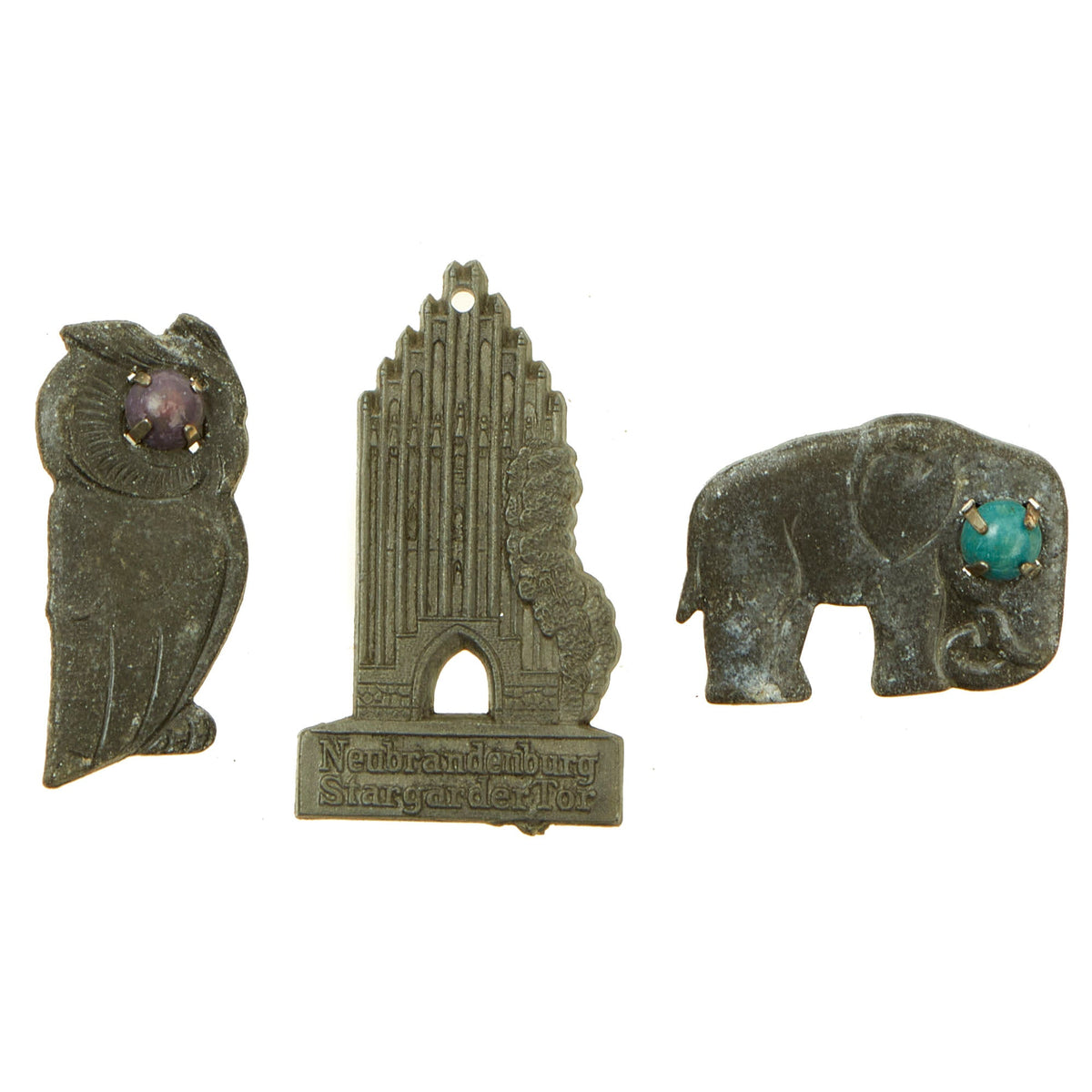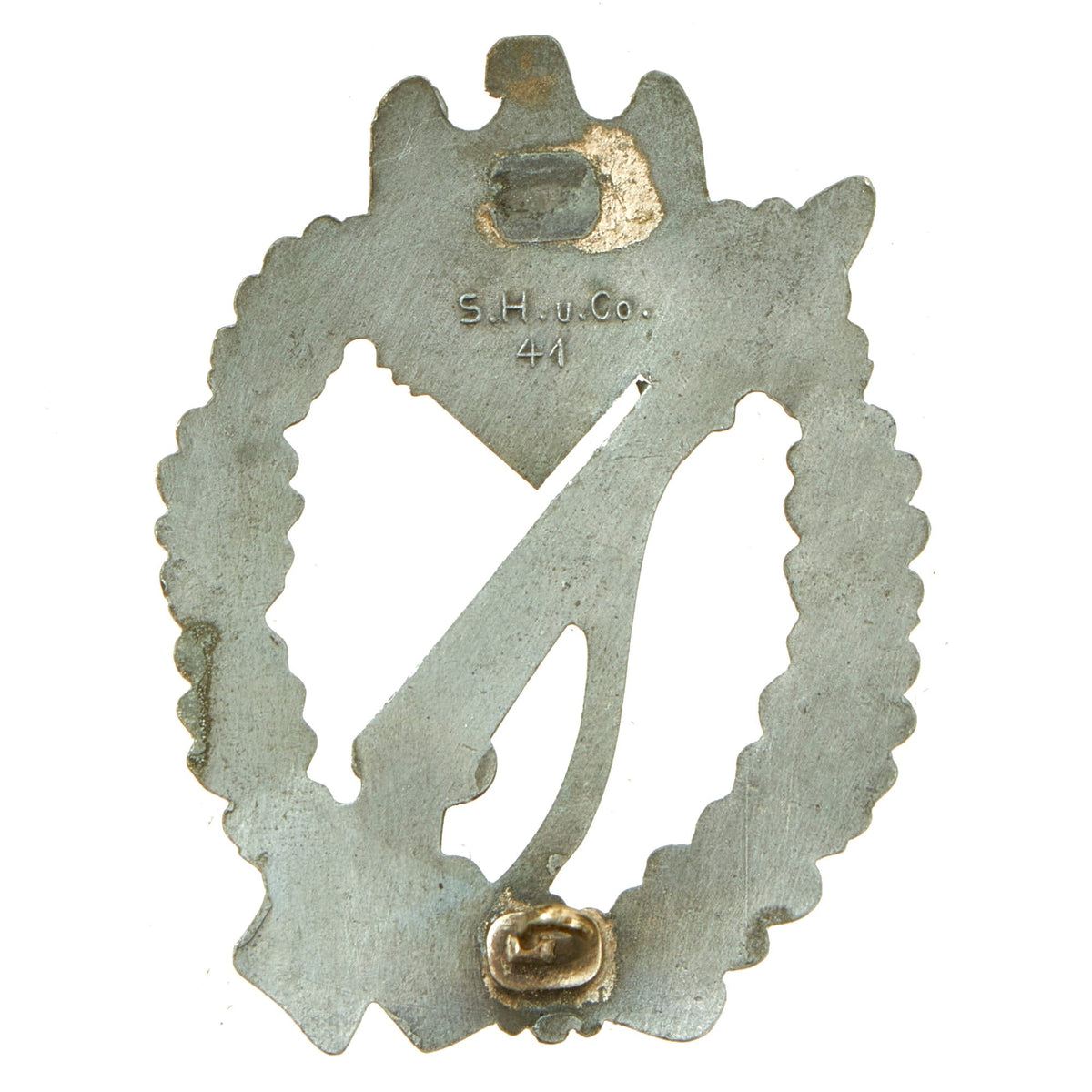Original German WWII Medal and Tinnie Pin Lot Featuring Infantry Assault Badge & Women’s Org. Badge – 24 Items Original Items
$ 250,00 $ 100,00
Original Items: Only One Set Available. This is a very nice collection of German WWII Insignia, Tinnies, and Awards, which was brought back from the European theater by a USGI after the war was concluded. Many solders traded these on the way back, and would end up with a pocket full of various different collectible items, and this set represents the typical “haul” one might have come back with.
It includes a wide variety of items, including:
– One German WWII Infantry Assault Badge (missing pinback), marked S. H. u. Co. / 41, for 1941 manufacture by Sohni Heubach & Co. of Oberstein, Germany, a known maker of these badges.
– One German WWII Era 1st Pattern Frauenschaft Women’s Organization Badge with a broken pinback, marked on the back with 92 (RZM), most likely for Karl Wild of Hamburg.
– Twenty-two “Tinnies” or even pins from all over Germany.
This set is FULL of research potential, and is just great. Ready to display!
“Tinnies” (Veranstaltungsabzeichen – Event Badge) are small commemorative pins or medals, acquired when one attended a specific event held in Germany. They were often made of thin stamped metal, bakelite, or even pressed paper. Many of these were given out as part of the WHW (Winterhilfswerk – Winter Help Work) Organization, which often involved Germans traveling quite a bit to help out the war effort.
The Infantry Assault Badge (Infanterie-Sturmabzeichen) was a German war badge awarded to Waffen-SS and Wehrmacht Heer soldiers during the Second World War. This decoration was instituted on 20 December 1939 by the Commander-in-Chief of the German Army, Generalfeldmarschall Walther von Brauchitsch. It could be awarded to members of non-motorized Infantry units and units of the Gebirgsjäger that had participated in infantry assaults, with light infantry weapons, on at least three separate days of battle in the front line on or after 1 January 1940. When a counter offensive led to fighting, it could also apply. Award of the Infantry Assault Badge was authorized at regimental command level.
More on the NS-Frauenschaft Women’s League
The National Socialist Women’s League (German: Nationalsozialistische Frauenschaft, abbreviated NS-Frauenschaft) was the women’s wing of the NSDAP Party. It was founded in October 1931 as a fusion of several nationalist and NSDAP women’s associations, such as the German Women’s Order (German: Deutscher Frauenorden, DFO) which had been founded in 1926. From then on, women were subordinate to the NSDAP Reich leadership. Guida Diehl was its first speaker (Kulturreferentin).
The Frauenschaft was subordinated to the national party leadership (Reichsleitung); girls and young women were the purview of the League of German Girls (Bund Deutscher Mädel, BDM). From February 1934 to the end of World War II in 1945, the NS-Frauenschaft was led by Reich’s Women’s Leader (Reichsfrauenführerin) Gertrud Scholtz-Klink (1902–1999). It put out a biweekly magazine, the NS-Frauen-Warte.
Its activities included instruction in the use of German-manufactured products, such as butter and rayon, in place of imported ones, as part of the self-sufficiency program, and classes for brides and schoolgirls. During wartime, it also provided refreshments at train stations, collected scrap metal and other materials, ran cookery and other classes, and allocated the domestic servants conscripted in the east to large families. Propaganda organizations depended on it as the primary spreader of propaganda to women.
Fast Shipping with Professional Packaging
Thanks to our longstanding association with UPS FedEx DHL, and other major international carriers, we are able to provide a range of shipping options. Our warehouse staff is expertly trained and will wrap your products according to our exact and precise specifications. Prior to shipping, your goods will be thoroughly examined and securely secured. We ship to thousands clients each day across multiple countries. This shows how we're dedicated to be the largest retailer on the internet. Warehouses and distribution centres can be located throughout Europe as well as the USA.
Note: Orders with more than one item will be assigned a processing date depending on the item.
Before shipping before shipping, we'll conduct a thorough inspection of the items you have ordered. Today, the majority of orders will be delivered within 48 hours. The delivery time will be between 3-7 days.
Returns
The stock is dynamic and we cannot completely manage it because multiple stakeholders are involved, including our factory and warehouse. So the actual stock may alter at any time. It's possible that you may not receive your order once the order has been made.
Our policy is valid for a period of 30 days. If you don't receive the product within 30 days, we are not able to issue a refund or an exchange.
You can only return an item if it is unused and in the same state as the day you received it. You must have the item in its original packaging.
Related products
Uncategorized
Uncategorized
Uncategorized
Uncategorized
Uncategorized
Uncategorized
Uncategorized
Armoured Fighting Vehicles of the World: AFVs of World War One (Hardcover Book) New Made Items
Uncategorized
Uncategorized
Uncategorized
Australian WWII Owen MK1 Machine Carbine SMG Custom Fabricated Replica with Sling Original Items
Uncategorized
Uncategorized
Uncategorized
Uncategorized
Uncategorized
Uncategorized
Uncategorized
Uncategorized
Uncategorized
Armored Burgonet Helmet & Polearm from Scottish Castle Leith Hall Circa 1700 Original Items
Uncategorized
Angolan Rebel 1970s era 60mm Inert Display Mortar from Angolan Civil War Original Items
Uncategorized












































































